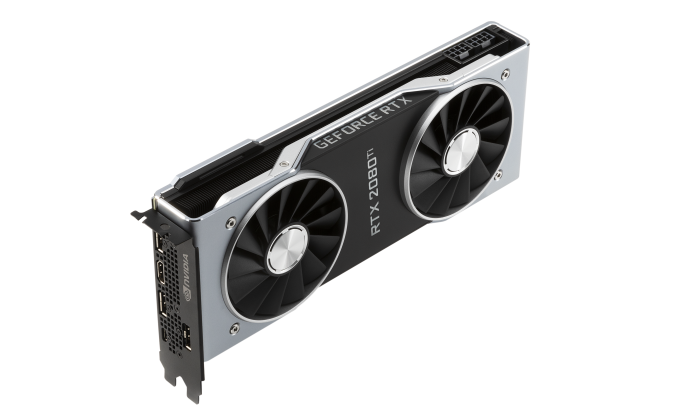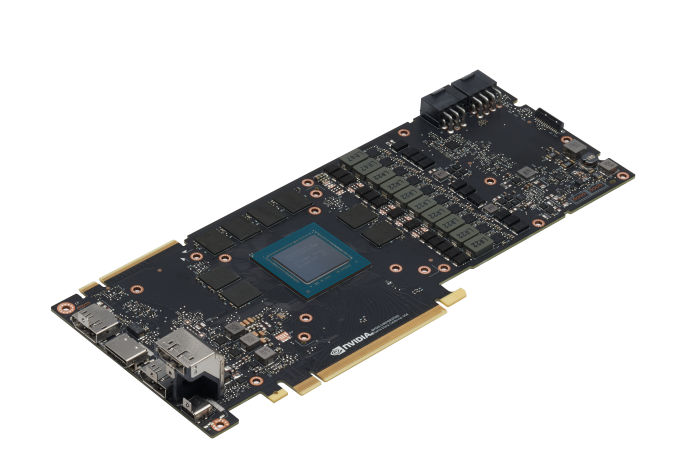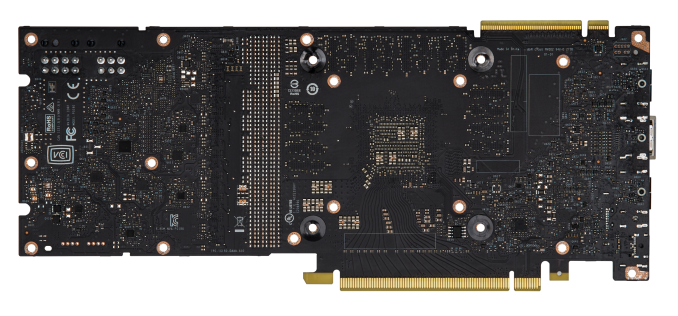The NVIDIA GeForce RTX 2080 Ti & RTX 2080 Founders Edition Review: Foundations For A Ray Traced Future
by Nate Oh on September 19, 2018 5:15 PM EST- Posted in
- GPUs
- Raytrace
- GeForce
- NVIDIA
- DirectX Raytracing
- Turing
- GeForce RTX
Meet The GeForce RTX 2080 Ti & RTX 2080 Founders Editions Cards
Moving onto the design of the cards, we've already mentioned the biggest change: a new open air cooler design. Along with the Founders Edition specification changes, the cards might be considered 'reference' in that they remain a first-party video card sold direct by NVIDIA, but strictly-speaking they are not because they no longer carry reference specifications.
Otherwise, NVIDIA's industrial design language prevails, and the RTX cards bring a sleek flattened aesthetic over the polygonal shroud of the 10 series. The silver shroud now encapsulates an integrated backplate, and in keeping with the presentation, the NVLink SLI connectors have a removable cover.
Internally, the dual 13-blade fans accompany a full-length vapor chamber and component baseplate, connected to a dual-slot aluminum finstack. Looking at improving efficiency and granular power control, the 260W RTX 2080 Ti Founders Edition features a 13-phase iMON DrMOS power subsystem with a dedicated 3-phase system for the 14 Gbps GDDR6, while the 225W RTX 2080 Founders Edition weighing in with 8-phases main and 2-phases memory.
As is typical with higher quality designs, NVIDIA is pushing overclocking, and for one that means a dual 8-pin PCIe power configuration for the 2080 Ti; on paper, this puts the maximum draw at 375W, though specifications-wise the TDP of the 2080 Ti Founders Edition against the 1080 Ti Founders Edition is only 10W higher. The RTX 2080 Founders Edition has the more drastic jump, however, with 8+6 pins and a 45W increase over the 1080's lone 8 pin and 180W TDP. Ultimately, it's a steady increase from the power-sipping GTX 980's 165W.
One of the more understated changes comes with the display outputs, which thanks to Turing's new display controller now features DisplayPort 1.4 and DSC support, the latter of which is part of the DP1.4 spec. The eye-catching addition is the VR-centric USB-C VirtualLink port, which also carries an associated 30W not included in the overall TDP.
Something to note is that this change in reference design, combined with the seemingly inherent low-volume nature of the Turing GPUs, cuts into an often overlooked but highly important aspect of GPU sales: big OEMs in the desktop and mobile space. Boutique system integrators will happily incorporate the pricier higher-end parts but from the OEM’s perspective, the GeForce RTX cards are not just priced into a new range beyond existing ones but also bringing higher TDPs and no longer equipped with blower-style coolers in its ‘reference’ implementation.
Given that OEMs often rely on the video card being fully self-exhausting because of a blower, it would certainly preclude a lot of drop-in replacements or upgrades – at least not without further testing. It would be hard to slot into the standard OEM product cycle at the necessary prices, not to mention the added difficulty in marketing. In that respect, there is definitely more to the GeForce RTX 20 series story, and it’s somewhat hard to see OEMs offering GeForce RTX cards. Or even the RT Cores themselves existing below the RTX 2070, just on basis of the raw performance needed for real time ray tracing effects at reasonable resolutions and playable framerates. So it will be very interesting to see how the rest of NVIDIA’s product stack unfolds.
















337 Comments
View All Comments
Qasar - Wednesday, September 19, 2018 - link
just checked a local store, the lowest priced 2080 card, a gigabyte rtx 2080 is $1080, and thats canadian dollars... the most expensive RTX card ..EVGA RTX 2080 Ti XC ULTRA GAMING 11GB is $1700 !!!! again that's canadian dollars !! to make things worse.. that's PRE ORDER pricing, and have this disclaimer : Please note that the prices of the GeForce RTX cards are subject to change due to FX rate and the possibility of tariffs. We cannot guarantee preorder prices when the stock arrives - prices will be updated as needed as stock become available.even if i could afford these cards.. i think i would pass.. just WAY to expensive.. id prob grab a 1080 or 1080ti and be done with it... IMO... nvida is being a tad bit greedy just to protect and keep its profit margins.. but, they CAN do this.. cause there is no one else to challenge them...
PopinFRESH007 - Wednesday, September 19, 2018 - link
would you care to share the bill of materials for the tu102 chip? Since you seem to suggest you know the production costs, and therefor know the profit margin which you suggest is a bit greedy.Qasar - Wednesday, September 19, 2018 - link
popin.. all i am trying to say is nvidia doesnt have to charge the prices they are charging.. but they CAN because there is nothing else out there to provide competition...tamalero - Thursday, September 20, 2018 - link
Please again explain how the cost of materials is somehow relevant on the price performance argument for consumers?Chips like R600, Fermi, similars.. were huge.. did it matter? NO, did performance matter? YES.
PopinFRESH007 - Thursday, September 20, 2018 - link
I specifically replied to Qasar's claim "nvida is being a tad bit greedy just to protect and keep its profit margins.. but, they CAN do this" which is baseless unless they have cost information to know what their profit margins are.Nagorak - Thursday, September 20, 2018 - link
Nvidia is a public company. You can look up their profit margin and it is quite high.Qasar - Thursday, September 20, 2018 - link
PopinFRESH * sigh * i guess you will never understand the concept of " no competition, we can charge what ever we want, and people will STILL buy it cause it is the only option if you want the best or fastest " it has NOTHING to do with knowing cost info or what a companies profit margins are... but i guess you will never understand this....just4U - Thursday, September 20, 2018 - link
Ofcourse their being greedy. Since they saw their cards flying off the shelfs at 50% above MSRP earlier this year they know people are willing to pay.. so their pushing the limit. As they normally do.. this isn't new with Nvidia. Not sure why any are defending them.. or getting excessively mad about it. (..shrug)mapesdhs - Wednesday, September 26, 2018 - link
Effectively, gamers are complaining about themselves. Previous cards sold well at higher prices, so NVIDIA thinks it can push up the pricing further, and reduce product resources at the same time even when the cost is higher. If the cards do sell well then gamers only have themselves to blame, in which case nothing will change until *gamers* stop making it fashionable and cool to have the latest and greatest card. Likewise, if AMD does release something competitive, whether via price, performance or both, then gamers need to buy the damn things instead of just exploiting the lowered NVIDIA pricing as a way of getting a cheaper NVIDIA card. There's no point AMD even being in this market if people don't buy their products even when it does make sense to do so.BurntMyBacon - Thursday, September 20, 2018 - link
@PopinFRESH007: "would you care to share the bill of materials for the tu102 chip? Since you seem to suggest you know the production costs, and therefor know the profit margin which you suggest is a bit greedy."You have a valid point. It is hard to establish a profit margin without a bill of materials (among other things). We don't have a bill of materials, but let me establish some knowns so we can better assess.
Typically, most supporting components on a graphics card are pretty similar to previous generation cards. Often times different designs used to do the same function are a cost cutting measure. I'm going to make an assumption that power transistors, capacitors, output connectors, etc. will remain nominally the same cost. So I'll focus on differences. The obvious is the larger GPU. This is not the first chip made on this process (TSMC 12nm) and the process appears to be a half node, so defect rates should be lower and the wafer cost should be similar to TSMC 14nm. On the other hand, the chip is still very large which will likely offset some of that yield gain and reduce the number of chips fabricated per wafer. Pascal was first generation chip produced on a new full node process (TSMC 14nm), but quite a bit smaller, so yields may have been higher and there were more chips fabricated per wafer. Also apparent is the newer GDDR6 memory tech, which will naturally cost more than GDDR5(X) at the moment, but clearly not as much as HBM2. The chips also take more power, so I'd expect a marginal increase for power related circuitry and cooling relative to pascal. I'd expect about the same cost here as for maxwell based chips, given similar power requirements.
From all this, it sounds like graohics cards based on Turing chips will cost more to manufacture than Pascal equivalents. I it is probably not unreasonable to suggest that a TU106 may have a similar cost bill of materials to a GP102 with the note that the cost to produce the GP102 has most certainly dropped since introduction.
I'll leave the debate on how greedy or not this is to others.